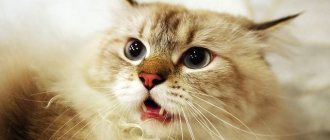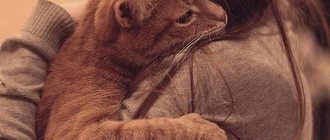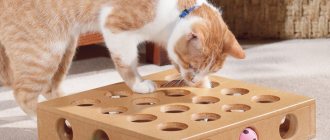Pregnancy in a cat: basic concepts
Cats are animals that mature quite early. Most often, they reach sexual maturity by the age of one year. But there are cases when the first pregnancy occurred at the age of six months, and even at four months.
In cats, the average age of sexual maturity is 9–12 months.
But it is undesirable to breed pets before they are one and a half years old . Only at this age is the animal fully ready to bear and give birth to a healthy kitten without harm to itself and the offspring.
A cat is capable of bearing healthy offspring only at the age of at least one and a half years
A cat's heat lasts approximately one week. Its duration is individual and depends on factors such as:
- hormonal background - the less the hormone responsible for preparing the cat’s body for mating and pregnancy is released, the more unnoticeably the estrus passes;
- breed - for example, British cats breed less often than European shorthairs;
- the presence or absence of matings and births - as a rule, estrus in a cat that has mated and given birth at least once occurs from 2 to 4 times a year, in animals that have not given birth (or have not had a single mating) estrus occurs more often - 1 or 2 times a month;
- age - the older your pet gets, the more its reproductive functions deteriorate, and therefore the number of estruses decreases.
The first heat is often unnoticeable and occurs without pronounced changes in the pet’s behavior. But if a cat goes through every heat like this, this is a reason to contact a veterinarian.
Some cats can become pregnant as early as six months of age
(63–65 days), which is how long a cat's pregnancy usually lasts. But everything depends on the breed, and the period may be different: from 56 to 70 days.
After childbirth
Pregnancy and childbirth take a lot of energy from cats. So after giving birth, the animal definitely needs to rest for some time. Usually during this period they simply indulge in dozing. In some cases, during the first two days, a young mother may experience diarrhea and vomiting. This is a normal phenomenon associated with her eating the placenta and licking newborn babies.
But the presence of constipation should alert the owners. If the situation with your cat’s stool does not return to normal within the next 24 hours, then it makes sense to contact a veterinarian. This symptom may be caused by retained fetus or placenta.
Vaginal discharge can be observed in a cat for another 7-10 days after birth. If their color is red-brown and there is no unpleasant odor, then they should not cause concern.
In conclusion, it is worth reassuring particularly worried owners of British cats. These creatures are absolutely self-sufficient. Typically, representatives of this breed calmly tolerate pregnancy and cats cope well with childbirth, as well as with raising offspring without the intervention of their owners.
Signs of pregnancy in a cat
Cats giving birth for the first time give birth to 1 to 3 kittens. Their litter is small due to the fact that the reproductive system is not fully formed and has not fully strengthened. In subsequent pregnancies they can give birth to up to 8 cubs. It is extremely rare to have more. A cat has only 8 nipples, so it is designed by nature that a mustachioed mother is simply not able to feed a larger litter. As a cat ages, the reproductive function of a cat works worse and worse, so in the last litters the cat again gives birth to no more than three or four kittens.
Typically, a cat's litter does not contain more than 8 kittens; on average, 3–5 babies are born
The record for the number of kittens in one litter belongs to a Burmese cat from England: she gave birth to 19 babies, four of which did not survive.
Based on certain signs, you can suspect that your cat is pregnant:
- The cat's heat suddenly stops and does not resume;
- no interest in cats;
- if the cat used to get along with other pets, but suddenly became aggressive towards them;
- nipples become swollen, acquire a bright pink color, and their sensitivity increases;
- the appetite increases, so the cat tries to get the nutrients that future kittens need;
- the pet becomes much more affectionate and sociable towards its owners, and, on the contrary, treats strangers too warily (this sign indicates a probable pregnancy only in conjunction with others);
- Nausea and vomiting may occur in the morning;
- the belly becomes larger than it was before, but note: if the cat has become very fat not only in the belly, but also in other parts of the body, it is very likely that your pet is obese and not pregnant.
A clear sign of pregnancy in a cat is swollen nipples.
Never attempt to palpate embryos in a pregnant cat yourself. This can injure not only future kittens, but also the mother.
Mating and early pregnancy
How to determine if a cat is pregnant? A healthy cat is usually ready to breed within 8-10 months after birth. In some individuals, estrus may begin even earlier - already at six months of age.
However, this does not mean at all that it is time to start looking for a cat. It is optimal to carry out the first mating at the age of 1-1.5 years. By this point, the cat’s body will be sufficiently strong and will be finally ready to bear offspring. So, the mating happened.
But how can you determine if a cat is pregnant at home? It is quite difficult to answer this question. From the moment of mating until the end of the heat, the cat continues to ask the cat, lie around and show all the signs of “desire”. So it’s not possible to immediately understand how successful the mating was.
The first obvious symptoms of pregnancy in cats become visible only at 3 weeks. In general, the length of pregnancy in British cats can vary between 8-9 weeks.
Determining the gestational age of cats is quite problematic. But there are still some guidelines. Between 15 and 21 days after conception, the cat's nipples become swollen and pink. This is what indicates that kittens will soon appear in the house.
The behavior also changes slightly: the pet becomes calmer. During this period of pregnancy, cats experience an increased appetite.
Pathologies and complications
During pregnancy, a cat may encounter some pathologies:
- We'll miscarry. Occurs especially often in the 4th–5th week of pregnancy. It is impossible to stop or reverse it. You can prevent this by regularly seeing your pet at the veterinarian. Miscarriage can occur due to: infection;
- injuries;
- fetal pathologies;
- severe stress;
- obesity;
- exhaustion;
- inbreeding;
- worm infections.
Using an ultrasound, you can not only confirm pregnancy, but also make sure that the embryos are developing correctly
The course of a cat's pregnancy can be complicated by:
- Obesity. It occurs due to improper feeding and low physical activity of the cat. Therefore, strictly follow the rules of nutrition for a pregnant woman and involve your pet in outdoor games with a low degree of activity of the animal.
- Kidney failure. May appear due to incomplete emptying of the bladder. You can give your cat special diuretic drugs or decoctions of diuretic herbs, but before doing so, be sure to consult a veterinarian.
- Dystrophy. Appears due to illiterate feeding or due to the stressful state of the cat.
- Arrhythmia. Make sure your cat is not overly active, especially in the second half of pregnancy.
After pregnancy, mastitis may develop. This occurs due to stagnation of milk in the mammary glands or due to hypothermia of the nipples. Mastitis can be prevented by providing a warm place for the nursing mother away from drafts. You also need to make sure that your pet spends most of her time with the kittens. With their constant sucking they will protect the mother from stagnation of milk. If mastitis does develop, the veterinarian will prescribe medication and massage.
At the end of the term
A couple of weeks before giving birth, the expectant mother looks for a convenient place, hidden from view, where she will give birth and feed the kittens. It is better if the owner arranges it himself and prepares everything necessary. Harbingers of imminent labor include discharge from the vulva, nipples, and drowsiness.
The cat gives birth approximately 2 months after fertilization by the male. It is advisable that the owner or a visiting veterinarian be with her at this time, especially for the first time. On the eve of birth, the pet’s body temperature drops and appetite worsens.
The birth of kittens begins with the breaking of water and subsequent contractions. It is necessary to ensure that the birth of each fetus does not take too long (maximum 5-6 hours).
After the process is completed, the mother and cubs need rest. It is advisable to provide all the conditions so that she does not have to go far from the “nest” - put food, water, and a litter tray nearby.
Features of pregnancy
During pregnancy, a cat can change beyond recognition. She stops eating her favorite foods, is prone to mood swings, is drowsy and passive. The owner should not be afraid of such changes: this is quite normal for a pregnant cat.
Cat behavior
In the first half of pregnancy, the cat is active and may show aggression towards other animals. This happens due to hormonal changes in the body, which makes the animal rather unbalanced. For no apparent reason, biting the owner and a minute later fawning over him is a common occurrence for a cat in the first month of pregnancy.
In the second half of pregnancy, the cat's behavior changes. The attitude towards people and animals around you becomes more favorable. Towards the end of pregnancy, cats tend to become lethargic, passive and even indifferent to walks. They spend most of the day in a state of sleep. There are no other changes in the habits of a cat who is about to give birth.
During the first month of pregnancy, a cat may be aggressive towards other animals.
A feature of the last days of pregnancy is “nesting”. During this, the cat begins to quickly select a place to give birth. The owner may find a pet exploring the depths of a closet or the back of a sofa. It is better to prepare a warm, secluded place for the cat to give birth (a basket or box with bedding) in advance.
Video: features of pregnancy in domestic cats
Caring for a pregnant cat
A pregnant cat's body functions a little differently, so she needs special care. Most of all this concerns nutrition.
Nutrition
If your cat is pregnant, special attention should be paid to the diet:
- During the first week, the cat eats as before.
- At 2–3 weeks, the cat should receive 10% more food than before. Feed should be frequent, but in small portions. This is extremely important, since the cat’s stomach is small, and the uterus constantly increases in size during pregnancy. Therefore, it will be difficult for the animal’s body to digest a large amount of food. If a cat is overfed, there is a risk of obesity. In this case, childbirth will be difficult. Also, if the portion size is too large, the kittens will form larger, which can also complicate childbirth.
- From the 3rd to the 7th week, the cat begins to eat more, so the diet should be increased by 40–50% and the pet should be fed 5–6 times a day.
- from the seventh week, appetite worsens, as the enlarged uterus puts pressure on the stomach. You also need to feed the cat 5-6 times a day, but reduce the portions by 30%.
If the cat refuses to eat, this means that labor may occur soon, so it is better to provide the cat with complete rest.
By the third week, your cat may stop eating the foods she loved before pregnancy.
For each pregnant cat, the diet is completely different, because when creating a menu, you need to take into account the breed, weight and much more. But some foods must definitely be in the diet of a pregnant cat. It is highly advisable to include beef, turkey, and chicken in your cat’s diet. But you shouldn’t give fish, only occasionally you can treat your pet to low-fat boiled fillet. You can also give your cat dairy products, but watch the amount (no more than 50–70 g) to avoid stomach upset.
Remember that in the first half of pregnancy, the cat requires large quantities of foods containing calcium, and in the second half - more protein.
For variety, the cat should be given egg yolk, rice or buckwheat porridge. Important foods for getting the necessary nutrients are grated carrots, fresh sour milk, zucchini and cabbage. But if the cat is not used to eating natural products, but eats ready-made food, you need to choose a special product. Calculate the portion according to the instructions, which are usually on the package. Vitamins are beneficial for a pregnant cat, so buy fortified and mineralized food. Veterinarians and experienced breeders recommend using only premium and super premium food, as well as food for kittens. Verified brands:
- Royal Canin;
There are special ready-made foods for pregnant and lactating cats. - Akana;
- Nutra Gold;
- Bosch;
- Orijen;
- Innova evo.
The best vitamins for a pregnant cat are:
- Doctor Zoo;
- Brevens Excel 8 in 1;
- Canina;
- Seva.
Vitamins are important for a cat during pregnancy.
In the second half of pregnancy, it is allowed to add finely chopped fresh nettle leaves to the diet, which should be scalded with boiling water, or a decoction of raspberry leaves. The first will help improve lactation, and the second will make childbirth easier. Some pets have constipation; vegetable puree or wheat germ can help correct this.
During pregnancy, you should not feed your cat smoked, salted or fried foods. They will not bring benefits not only to a pregnant cat, but also to an ordinary cat.
Other care
You can wash and bathe your cat during pregnancy. But you should be careful not to overcool your pet. You need to make sure that all the windows in the room are closed, because a draft is dangerous for a pregnant cat. Bathing should be avoided if the animal is afraid of water. In this case, the cat will be able to keep itself clean.
A pregnant cat should only be washed if she is not afraid of water.
The owner must closely monitor the pet so that the cat cannot harm itself and future kittens, and do not let it jump from high objects. It is also necessary to monitor the cleanliness of the cat’s litter and the condition of the cat itself: with a damp cloth, clean those places on the animal’s body that it cannot reach while “washing”, and carefully comb out the fur.
How to act when giving birth to a cat
So, the crucial moment is approaching - your pet’s birth. Don’t rush to worry, because a lot depends on you too. It is you who will observe the birth process, in a difficult situation you will be able to provide first aid and, possibly, save the lives of little kittens and their mother.
Preparing for childbirth
To give birth to a cat, you may need the following items:
- disposable diapers;
- gauze napkins 20x20;
- thick silk threads for tying the umbilical cord;
- scissors with rounded ends;
- medical alcohol for sterilizing scissors;
- hydrogen peroxide;
- synthomycin ointment;
- streptocide powder;
- a small syringe for sucking liquid from a newborn’s nose;
- an unbreakable vessel with water (this is where you will place the afterbirth);
- heating pad for newborns.
Video: what to prepare for the birth of a cat
Signs of approaching labor
If the cat does not eat anything and tries to find a secluded place, this means that birth is near. Approximately 12–14 hours before giving birth, the cat's body temperature begins to gradually decrease and usually reaches 37.8 0C. The cat may meow a lot, becomes restless and excited, and carefully licks its body.
If a pregnant cat begins to look for a secluded place, behaves restlessly and meows incessantly - these are sure signs that labor is approaching.
Correct actions during childbirth
Childbirth, as a rule, lasts from 2 to 3 days. Stages of childbirth:
- Stage 1. Mild contractions and opening of the cervix. There is scanty bleeding. The abdomen is tense and hard. The cat is in severe pain and meows. The owner must be nearby to calm the pet. The duration of the first stage is up to 36 hours.
- Stage 2. Quite strong contractions with the release of water. You need to pay attention to the color of the water, since a dark or bloody color indicates bleeding (in this case, you should call a veterinarian). After the water breaks, the process of giving birth to kittens begins. The first kitten is born longer than others, but if after 3.5–4 hours it is still not born, call the veterinarian immediately.
- Stage 3. Calm state of the cat in the intervals (from 5 minutes to 3-4 hours) between the birth of kittens. At this time, the cat licks the newborns and gives birth to the placenta.
The cat itself gnaws the umbilical cord and licks its baby. The kitten is born in the fetal bladder, but usually the cat breaks it so that the cub does not suffocate and die. Sometimes the cat doesn't do this. In this case, responsibility for this falls on the owner:
- Take scissors with rounded ends, sterilize them with alcohol and cut the bubble film.
- Proceed with extreme caution so as not to harm the kitten.
- After removing the kitten from the bubble, wipe it with a diaper, paying special attention to its face.
The liquid in the bladder can get into the kitten's nose; if this happens, you need to carefully and thoroughly wipe his nose or suck out the liquid with a syringe. It’s good if, after bursting the bladder and wiping its nose, the kitten breathes, squeaks and moves. If this does not happen, liquid has probably entered the kitten’s respiratory tract. In this case, the cub is very carefully taken, turned over with its nose down and gently shaken, while holding its head, or gently bend it several times into an arc so that the hind legs touch the chest. This must be done until the kitten begins to breathe. Afterwards, his face needs to be wiped.
Particular attention should be paid to how the kitten breathes and to its tongue. The newborn's breathing should be smooth and without wheezing. The tongue should be pink; if it acquires a blue tint, this means that it lacks oxygen. In this case, you need to immediately take a soft cloth and wrap the kitten in it; after that, lower it head down until the first inhalation.
The breathing of a newborn kitten should be without wheezing and even, and the tongue should be pink.
If for some reason the cat cannot gnaw the umbilical cord, then you need to take scissors and wipe them well with alcohol. Then proceed as follows:
- Drag the umbilical cord with a thread one or two centimeters from the kitten's tummy and carefully cut it 1 cm above the thread. Proceed as carefully as possible!
- Lubricate the incision site with iodine.
- Tighten the umbilical cord as tightly as possible, because if the thread comes undone before the umbilical cord heals, the kitten may die from blood loss.
During childbirth, the cat is in an excited state and can seriously injure the kitten by rupturing the fetal bladder or gnawing the umbilical cord. Therefore, the owner needs to carefully monitor her. If this is her first birth, it is better to help her perform all the necessary manipulations or do everything for her.
Before the birthing process is completed, the kittens should be thoroughly dried with a diaper, separated from the cat for a while, and placed in a warm place (maybe in a basket with a warm, but not hot, heating pad or a bottle of warm water covered with a soft cloth). After the birth is completed, the kittens are returned to their mother.
If the kitten's umbilical cord does not dry out within one to two weeks, contact your veterinarian immediately: the remaining section of the umbilical cord may rot and the kitten will die from blood poisoning.
It also happens that after the birth of several kittens, a period of rest begins for up to 12 hours. The cat behaves as usual after giving birth, but there are clearly still kittens in the stomach. Don't worry - labor will resume in 5-12 hours.
The following birth complications may occur:
- The kitten's head is visible, but it is not born for a long time. It is necessary to lubricate the cat's genitals and the fetal head with Vaseline. After this, the process returns to normal.
- Mechanical blockage - the fetus is too large or does not lie correctly, the cat cannot give birth to it. In this case, stimulant drugs cannot be used, as this can lead to rupture of the animal’s internal organs. It is better to urgently call a doctor who will take all necessary measures.
- Uterine atony - the contraction force is not enough to release the fetus. This complication occurs in multiple pregnancies, when 4 or more kittens are born. The uterus responds well to oxytocin injections, the first of which can be done independently. 0.2–0.3 ml of the drug is injected into the withers once. At this time, the birth canal should be open. If the contractions slow down after the injection and the kitten is stuck in the birth canal, it must be carefully released by pulling it out by the skin. However, remember that there are several contraindications for oxytocin injections: scars on the uterus;
- mechanical blockade;
- renal failure;
- intestinal obstruction;
- individual intolerance;
- tachycardia;
- bronchospasm;
- Fruit size is too large.
At the end of labor, be sure to count the number of placentas. It should be equal to the number of kittens. If there are fewer placentas, this means that some remained in the birth canal. This threatens serious inflammation, so you need to call a veterinarian.
After the birth is over, the cat needs to be given complete rest, a tray and a bowl filled with food should be placed next to it. This is necessary so that she does not go far and for a long time from the kittens. For some time, no one except the owner should approach the cat, otherwise she may hide the kittens, and it will be difficult to find them. Your pet should be given food four or five times a day in small portions. You need to clean your cat's litter once a day. There should always be fresh and clean drinking water close to the cat. Some nursing cats may have seizures due to a lack of calcium in the body. If you notice this, you should call your veterinarian immediately.
There is an opinion that for better lactation, a cat should be given one or two afterbirths to eat. But in the wild, a cat eats the afterbirth in order to hide the smell of the cubs and to facilitate childbirth. The first afterbirth contains the hormone oxytocin in large quantities, which stimulates labor, so it is better to give only this to the cat. Don't give more than one or two, otherwise your cat can easily get an upset stomach.
After giving birth, the cat should be given time to rest and feed the kittens.
Heat during pregnancy
After fertilization of the eggs, the cat’s body produces hormones, under the influence of which the next heat does not occur after 3 weeks. However, in about 10 cases out of 100, a failure may occur, and the phenomenon of superfetation occurs - the ability to re-conceive kittens by having sexual intercourse with a male.
Such a pregnancy occurs with complications due to the larger number of developing fetuses, which have different ripening periods. At the birth of the first (older) litter, the second, later one is either also born or remains in the uterus until it grows up. In the first case, the offspring will not survive from repeated mating.
Cat sterilization
Many owners believe that sterilization is dangerous for their cat's health. But in reality this is not the case at all:
- sterilization reduces the risk of inflammation and tumors in the genitourinary system;
- during estrus, a cat may involuntarily defecate; sterilization eliminates this unpleasant effect;
- during the period of estrus, a cat can scream for several hours in a row, marks all objects in the house, rushes outside, sterilized cats do not have estrus, and they become calmer;
- if the animal spends most of its time outside and often walks, then kittens will appear from one to three times a year; sterilization helps prevent unwanted pregnancy;
- during estrus, the cat’s appearance changes (she loses a lot of weight, her coat becomes less shiny and falls out a lot, and a general deterioration in her condition appears), sterilization allows you to avoid this;
- If you don’t mate a cat regularly, it becomes irritable, angry, in other words, its nervous system is shaken; a sterilized cat is not susceptible to such problems.
Sterilizing cats has advantages not only for the owners, but also for the animals themselves.
It is better to sterilize a cat at seven or eight months. If this is done earlier, complications may arise after the operation and the cat's growth may be stunted. This can be stated with confidence, since such cases have occurred, and often. You can sterilize a cat at six months, if it is quite large, weighing at least three kilograms. After eight months, you can also do this operation, but every year the cat can get more and more complications after the operation and during anesthesia.
You need to start preparing your cat for sterilization a month before surgery:
- The operation can only be performed on a completely healthy animal.
- A month before sterilization, the cat must be vaccinated with a complex vaccination or given hyperimmune serum (globulin) before surgery.
- Be sure to deworm the cat with Drontal, Mibemax or Kanikquantel at least 1.5 months before surgery.
- Do not give your cat food for at least 12 hours before surgery. Do not give water 3 hours before surgery.
It is believed that male cats are castrated and male cats are sterilized. But in fact, females can undergo both castration (ovariohysterectomy) - complete removal of the reproductive organs, and sterilization (oophorectomy) - removal of only the ovaries. There is also such an operation as “tubal occlusion” - ligation of the fallopian tubes. During sterilization and tubal occlusion, the uterus remains in the abdominal cavity and does not perform any useful functions. It does not die or atrophy, since its blood supply is not disrupted. In addition, the hormones responsible for estrus continue to be released, and the cat's behavior does not change. When performing these operations, there remains a risk of developing uterine diseases: pyometra, endometritis and malignant tumors. That is why in modern veterinary clinics ovariectomy and tubal occlusion are practically not performed, preferring more effective castration. But for convenience, it is still called sterilization.
The most common complications after surgery are:
- Impaired healing of the external suture. It is necessary to ensure that the cat does not scratch or lick the seam until the wound is completely healed, otherwise the wound will easily become infected. For prevention, it must be treated with a disinfectant every day.
- Internal seams coming apart. This can happen if the cat is too active in the first couple of days after surgery. This situation threatens serious internal bleeding.
- Incomplete removal of reproductive organs. In this case, responsibility lies entirely with the veterinarian who performed the operation. Incomplete removal of the uterus and ovaries can lead to internal inflammation, which ultimately leads to the death of the cat.
But how can you tell if your pet is feeling well or if she urgently needs help? Here are the main signs of complications:
- severe swelling of the seam, redness;
- bleeding from the suture (if a few drops of blood are released, there is no need to worry);
- the appearance of pus (thick, mustard-colored discharge that smells unpleasant);
- pale mucous membranes and depressed mood of the cat (may indicate internal bleeding);
- the cat does not eat or drink on the 3rd–4th day after sterilization;
- high temperature that cannot be brought down;
- the cat doesn't go to the toilet.
Therefore, sterilization should be carried out at a young age to avoid many risks. Remember: if the animal’s diet does not change after sterilization, then it may soon become obese. To prevent this from happening, you need to reduce the portion by ten or twenty percent, feed the cat only low-fat foods and do not forget about physical activity.
In the first 2 weeks after surgery, it is better to limit the cat's mobility.
Here are some more tips for caring for your cat after surgery:
- During medicated sleep, the cat's eyes are open and the mucous membranes dry out. Place special drops in your pet's eyes every 20 minutes until the animal wakes up.
- After surgery, the cat's body temperature drops. Therefore, in the first postoperative hours, wrap the cat in a warm blanket.
- Usually the cat recovers from anesthesia within a day. At home, monitor its condition, keep it warm and do not place it on high surfaces: when waking up, the animal may suddenly rush around, fall and get hurt.
- In a state of anesthesia, the cat's movements are not coordinated. A “drunk” gait, helpless twitching of paws, involuntary urination, weak meowing and hissing can look scary, but don’t worry: every time the cat starts to worry and tries to walk, take it back to the basket, talk to it gently, and pet it.
- A blanket is put on the cat after surgery. It cannot be removed for 15 days.
- Limit your cat's mobility for the first 2 weeks after surgery, especially if she is left alone at home. This way the pet won’t be able to harm itself. It would be best to put her in a special enclosure.










